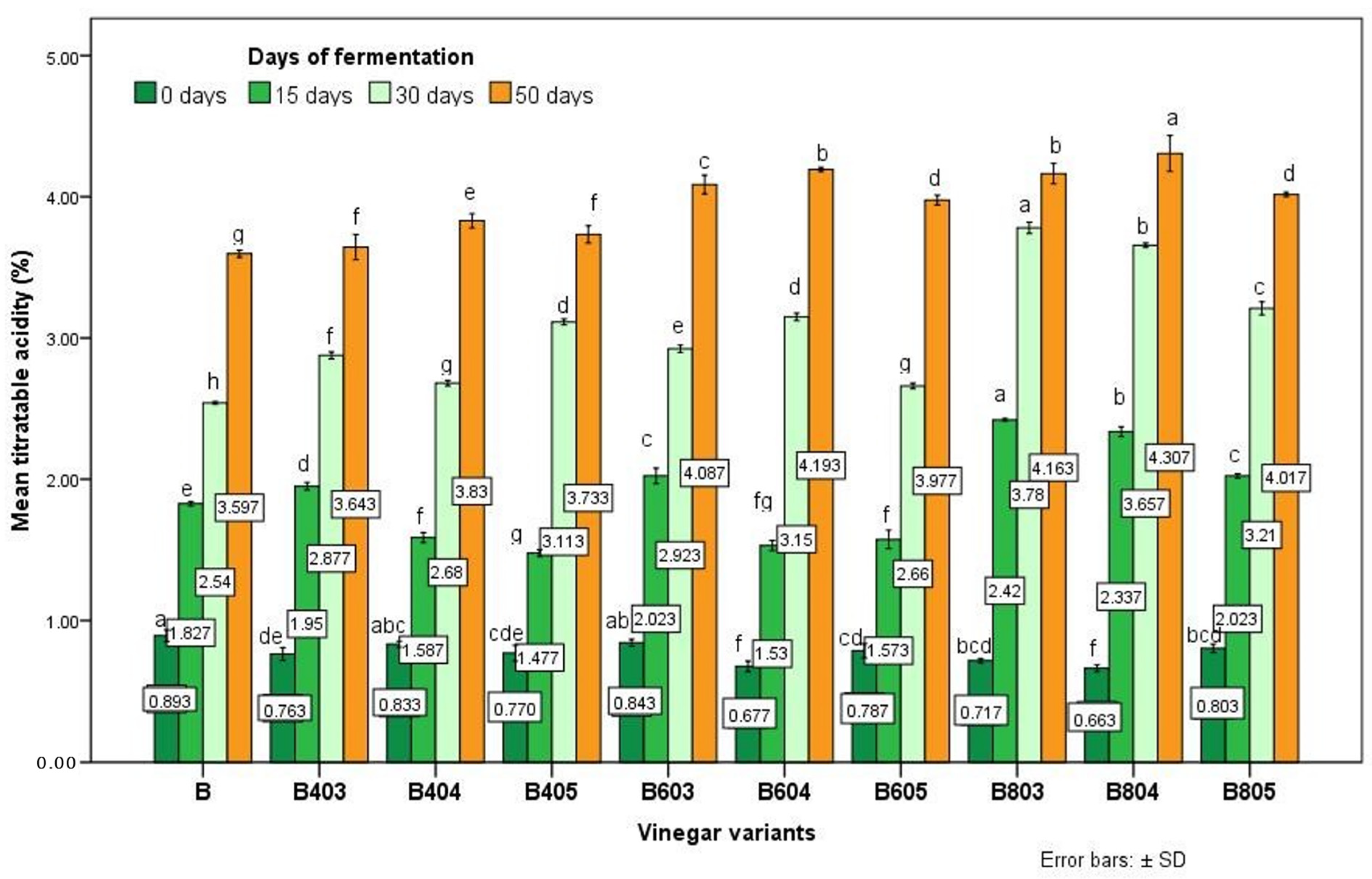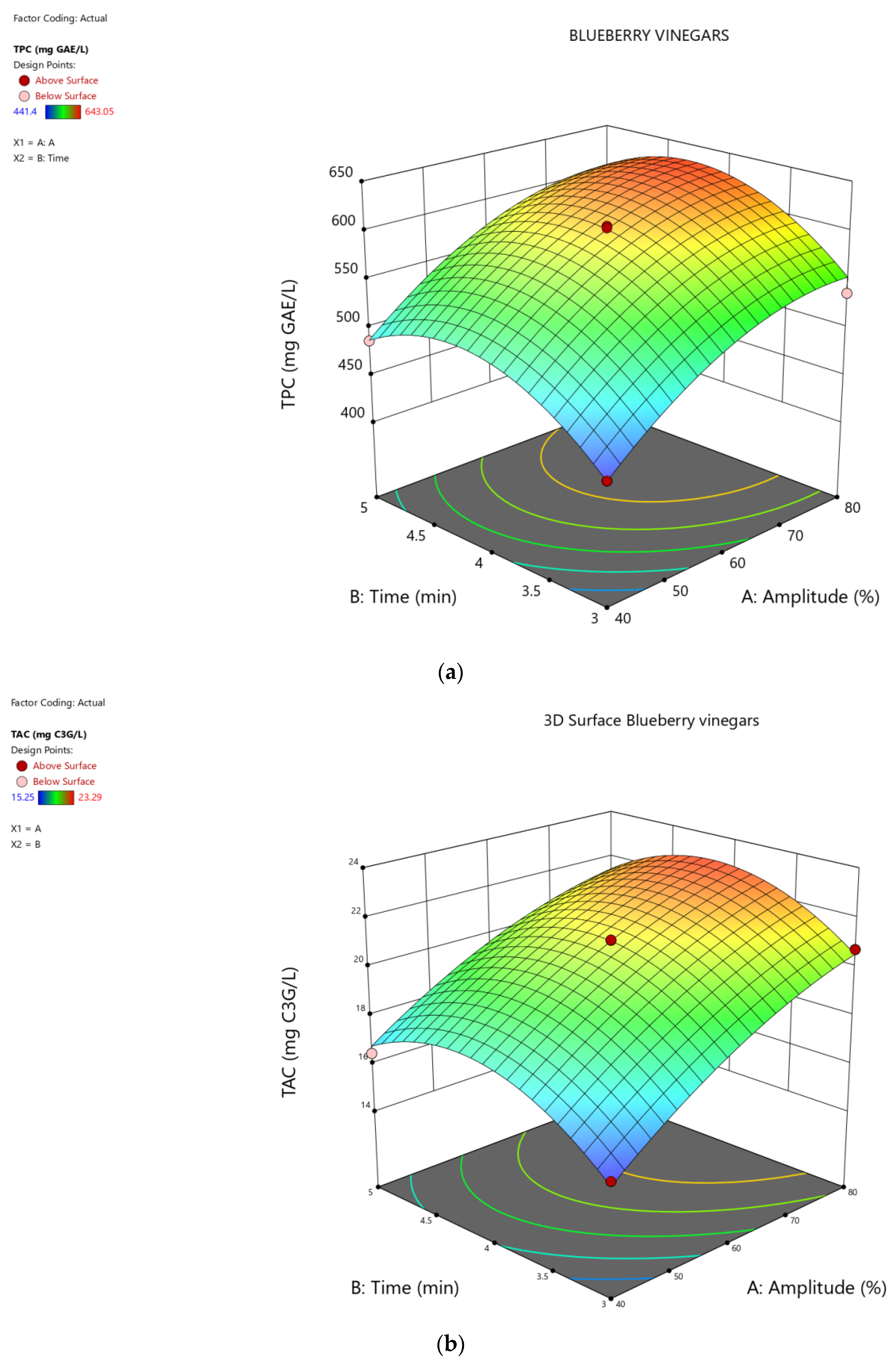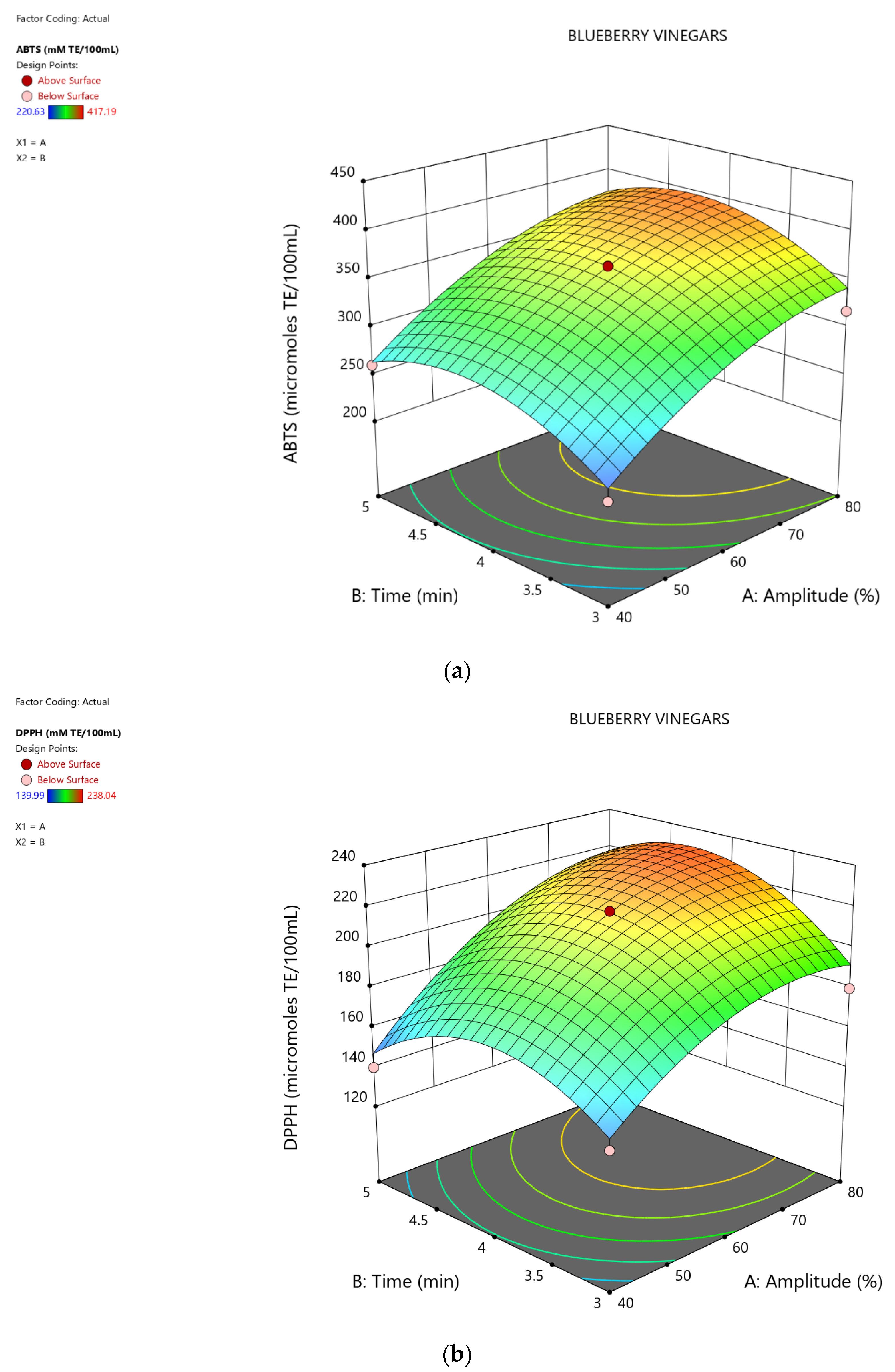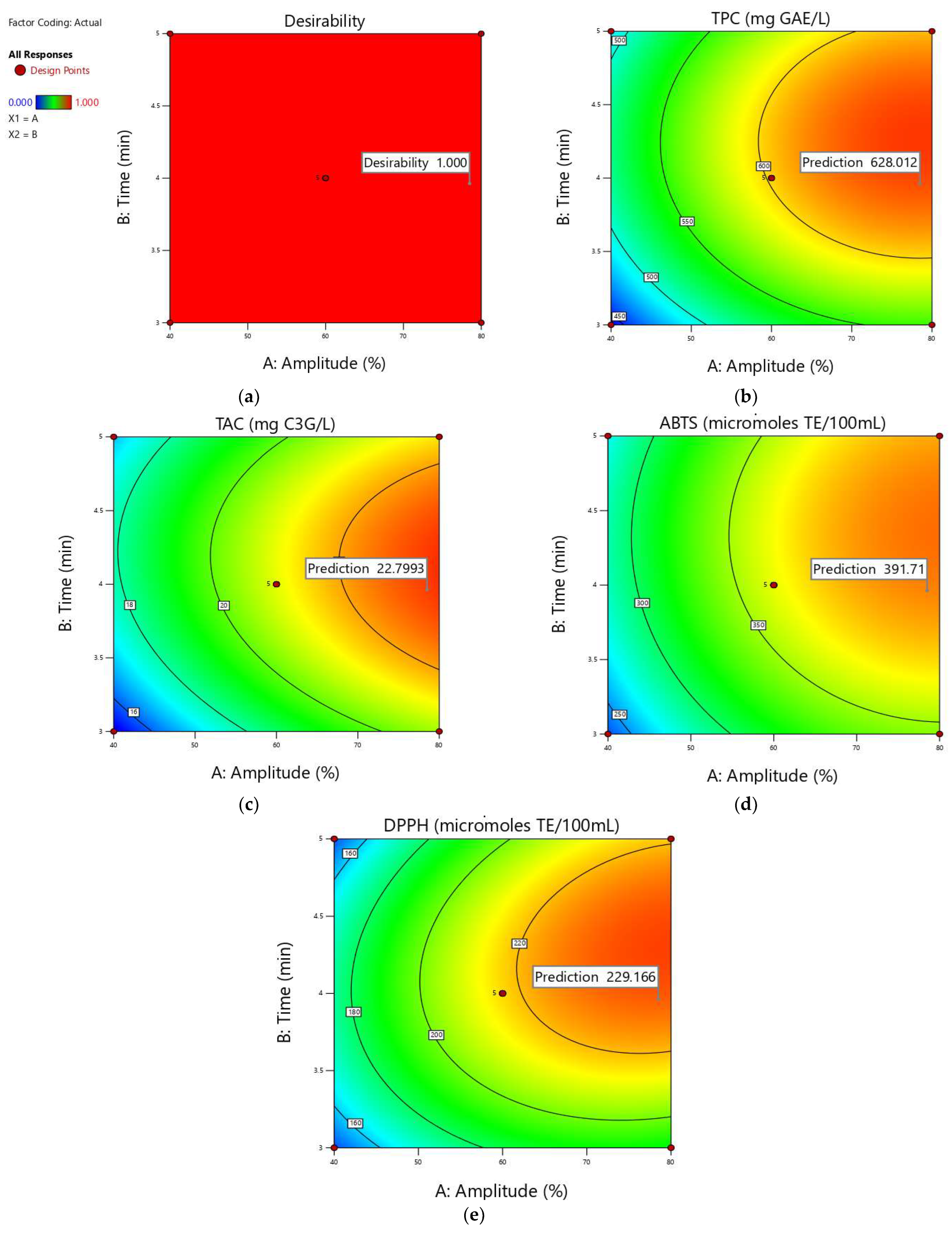Ultrasound Treatment Influence on Antioxidant Properties of Blueberry Vinegar
Abstract
:1. Introduction
2. Results and Discussion
2.1. Analysis of the Raw Material (Blueberry) and Blueberry Juices Obtained
2.2. Vinegars Variants Obtained (Acidity, TSS)
2.3. Total Phenolic Content and Total Antocyanins Content of Blueberry Vvinegars
2.4. Antioxidant Activity of Berry Vinegars
2.5. HPLC Analysis of Phenolic Compounds
2.6. Sensory Analysis
3. Materials and Methods
3.1. Materials, Reagents
3.2. Production of Berry-Vinegar Variants
3.3. Titratable Acidity, pH, and Total Soluble Solids
3.4. Ultrasound (US) Treatments
3.5. Factorial Experimental Design
3.6. Total Phenolic Content (TPC) and Total Monomeric Anthocyanins Content (TAC)
3.7. Antioxidant Activity
3.7.1. ABTS Assay
3.7.2. DPPH Assay
3.8. Polyphenols Profiles by HPLC Analysis
3.9. Sensory Analysis
3.10. Statistical Analysis
4. Conclusions
Author Contributions
Funding
Institutional Review Board Statement
Informed Consent Statement
Data Availability Statement
Acknowledgments
Conflicts of Interest
References
- Da Cunha, M.A.A.; De Lima, K.P.; Santos, V.A.Q.; Heinz, O.L.; Schmidt, C.A.P. Blackberry Vinegar Produced by Successive Acetification Cycles: Production, Characterization And Bioactivity Parameters. Braz. Arch. Biol. Technol. 2016, 59, 1–10. [Google Scholar] [CrossRef]
- Chen, H.; Chen, T.; Giudici, P.; Chen, F. Vinegar Functions on Health: Constituents, Sources, and Formation Mechanisms. Compr. Rev. Food Sci. Food Saf. 2016, 15, 1124–1138. [Google Scholar] [CrossRef]
- Yıkmış, S. Optimization of Uruset Apple Vinegar Production Using Response Surface Methodology for the Enhanced Extraction of Bioactive Substances. Foods 2019, 8, 107. [Google Scholar] [CrossRef] [PubMed] [Green Version]
- Yıkmış, S.; Bozgeyik, E.; Şimşek, M.A. Ultrasound processing of verjuice (unripe grape juice) vinegar: Effect on bioactive compounds, sensory properties, microbiological quality and anticarcinogenic activity. J. Food Sci. Technol. 2020, 57, 3445–3456. [Google Scholar] [CrossRef]
- Liu, Q.; Tang, G.-Y.; Zhao, C.-N.; Gan, R.-Y.; Li, H.-B. Antioxidant activities, phenolic profiles, and organic acid contents of fruit vinegars. Antioxidants 2019, 8, 78. [Google Scholar] [CrossRef] [Green Version]
- Solieri, L.; Giudici, P. Vinegars of the World. In Vinegars of the World, 1st ed.; Solieri, P., Giudici, L., Eds.; Springer: Milan, Italy, 2009; pp. 1–16. [Google Scholar]
- Catsberg, C.M.E.; Dommelen, G.J.M.K.-V. Vinegar. In Food Handbook; Springer: Dordrecht, The Netherlands, 1990; pp. 360–362. [Google Scholar]
- Driss, O. The Nutritional and Antioxidant Potential of Artisanal and Industrial Apple Vinegars and Their Ability to Inhibit Key Enzymes Related to Type 2 Diabetes In Vitro. Molecules 2022, 27, 567. [Google Scholar]
- Yıkmış, S.; Aksu, F.; Altunatmaz, S.S.; Çöl, B.G. Ultrasound processing of vinegar: Modelling the impact on bioactives and other quality factors. Foods 2021, 10, 1703. [Google Scholar] [CrossRef] [PubMed]
- Expert Market Research. Available online: https://www.expertmarketresearch.com/reports/vinegar-market (accessed on 9 January 2023).
- The State of Food and Agriculture 2019. Moving Fordward on Food Loss and Waste Reduction. Available online: https://scholar.google.com/scholar_lookup?title=The+State+of+Food+and+Agriculture+2019:+Moving+Fordward+on+Food+Loss+and+Waste+Reduction&author=Food+and+Agriculture+Organization&publication_year=2019 (accessed on 15 January 2023).
- Luzón-Quintana, L.M.; Castro, R.; Durán-Guerrero, E. Biotechnological processes in fruit vinegar production. Foods 2021, 10, 945. [Google Scholar] [CrossRef]
- Da Silva Fonseca, M.; Santos, V.A.Q.; Calegari, G.C.; Dekker, R.F.H.; De Melo Barbosa-Dekker, A.; Da Cunha, M.A.A. Blueberry and honey vinegar: Successive batch production, antioxidant potential and antimicrobial ability. Braz. J. Food Technol. 2018, 21. [Google Scholar] [CrossRef]
- Ho, C.W.; Lazim, A.M.; Fazry, S.; Zaki, U.K.H.H.; Lim, S.J. Varieties, production, composition and health benefits of vinegars. A review. Food Chem. 2017, 221, 1621–1630. [Google Scholar] [CrossRef]
- Trček, J.; Mahnič, A.; Rupnik, M. Diversity of the microbiota involved in wine and organic apple cider submerged vinegar production as revealed by DHPLC analysis and next-generation sequencing. Int. J. Food Microbiol. 2016, 223, 57–62. [Google Scholar] [CrossRef] [PubMed]
- Brezan, B.; Badarau, C.; Woinaroschy, A. Effects of Blueberry and Black Carrot Extracts Addition on Antioxidant Properties and Protein-Precipitating Capacity of Ultrasound-Treated Cider. Processes 2020, 8, 812. [Google Scholar] [CrossRef]
- Lieu, L.N.; Le, V.V.M. Application of ultrasound in grape mash treatment in juice processing. Ultrason. Sonochem. 2010, 17, 273–279. [Google Scholar] [CrossRef] [PubMed]
- Wen, C.; Zhang, J.; Zhang, H.; Dzah, C.S.; Zandile, M.; Duan, Y.; Ma, H.; Luo, X. Advances in ultrasound assisted extraction of bioactive compounds from cash crops. A review. Ultrason. Sonochem. 2018, 48, 538–549. [Google Scholar] [CrossRef]
- Xu, J.; Yang, H.; Zhang, C.; Liu, C. Optimised preparation and characterisation of lotus root starch oxidised with sodium hypochlorite (NaOCl) using response surface methodology. Czech J. Food Sci. 2022, 40, 61–68. [Google Scholar] [CrossRef]
- Xu, F.; Wang, B.; Hong, C.; Telebielaigen, S.; Nsor-Atindana, J.; Duan, Y.; Zhong, F. Optimization of spiral continuous flow-through pulse light sterilization for Escherichia coli in red grape juice by response surface methodology. Food Control 2019, 105, 8–12. [Google Scholar] [CrossRef]
- Zhang, X.; Zuo, Z.; Yu, P.; Li, T.; Guang, M.; Chen, Z.; Wang, L. Rice peptide nanoparticle as a bifunctional food-grade Pickering stabilizer prepared by ultrasonication: Structural characteristics, antioxidant activity, and emulsifying properties. Food Chem. 2021, 343, 128545. [Google Scholar] [CrossRef]
- Saftner, R.; Polashock, J.; Ehlenfeldt, M.; Vinyard, B. Instrumental and sensory quality characteristics of blueberry fruit from twelve cultivars. Postharvest Biol. Technol. 2008, 49, 19–26. [Google Scholar] [CrossRef]
- Colak, N.; Torun, H.; Gruz, J.; Strnad, M.; Subrtova, M.; Inceer, H.; Ayaz, F.A. Comparison of Phenolics and Phenolic Acid Profiles in Conjunction with Oxygen Radical Absorbing Capacity (ORAC) in Berries of Vaccinium arctostaphylos L. and V. myrtillus L. Polish J. Food Nutr. 2016, 66, 85–91. [Google Scholar] [CrossRef] [Green Version]
- Gibson, L.; Rupasinghe, H.P.V.; Forney, C.F.; Eaton, L. Characterization of Changes in Polyphenols, Antioxidant Capacity and Physico-Chemical Parameters during Lowbush Blueberry Fruit Ripening. Antioxidants 2013, 2, 216–229. [Google Scholar] [CrossRef] [Green Version]
- de Souza, V.R.; Pereira, P.A.; da Silva, T.L.; de Oliveira Lima, L.C.; Pio, R.; Queiroz, F. Determination of the bioactive compounds, antioxidant activity and chemical composition of Brazilian blackberry, red raspberry, strawberry, blueberry and sweet cherry fruits. Food Chem. 2014, 156, 362–368. [Google Scholar] [CrossRef] [PubMed] [Green Version]
- Almenar, E.; Samsudin, H.; Auras, R.; Harte, B.; Rubino, M. Postharvest shelf life extension of blueberries using a biodegradable package. Food Chem. 2008, 110, 120–127. [Google Scholar] [CrossRef] [PubMed]
- Bunea, A.; Rugina, O.D.; Pintea, A.M.; Sconţa, Z.; Bunea, C.I.; Socaciu, C. Comparative Polyphenolic Content and Antioxidant Activities of Some Wild and Cultivated Blueberries from Romania. Not. Bot. Horti Agrobot. Cluj-Napoca 2011, 39, 70–76. [Google Scholar] [CrossRef] [Green Version]
- Jacques, A.C.; Pertuzatti, P.B.; Barcia, M.T.; Zambiazi, R. Nota científica: Compostos bioativos em pequenas frutas cultivadas na região sul do Estado do Rio Grande do Sul. Braz. J. Food Technol. 2009, 12, 123–127. [Google Scholar] [CrossRef]
- Tarhon, M.C. Tehnologia Fabricării Oțetului; Fundației Universitare “Dunărea de Jos”: Galați, Romania, 2006. [Google Scholar]
- Bhat, R.; Shuaidda, N.; Min-Tze, L.; Karim, A.A. Sonication improves kasturi lime (Citrus microcarpa) juice quality. Ultrason. Sonochem. 2011, 18, 1295–1300. [Google Scholar] [CrossRef] [PubMed]
- Arvaniti, O.S.; Mitsonis, P.; Siorokos, I.; Dermishaj, E.; Samaras, Y. The physicochemical properties and antioxidant capacities of commercial and Homemade Greek Vinegars. Acta Sci. Pol. Technol. Aliment. 2019, 18, 225–234. [Google Scholar]
- Wang, C.C.; Chu, C.Y.; Chu, K.O.; Choy, K.W.; Khaw, K.S.; Rogers, M.S.; Pang, C.P. Trolox-equivalent antioxidant capacity assay versus oxygen radical absorbance capacity assay in plasma. Clin. Chem. 2004, 50, 952–954. [Google Scholar] [CrossRef]
- Xia, T.; Zhang, B.; Duan, W.; Zhang, J.; Wang, M. Nutrients and bioactive components from vinegar: A fermented and functional food. J. Funct. Foods 2020, 64, 103681. [Google Scholar] [CrossRef]
- Chou, C.H.; Liu, C.W.; Yang, D.J.; Wu, Y.H.; Chen, Y.C. Amino acid, mineral, and polyphenolic profiles of black vinegar, and its lipid lowering and antioxidant effects in vivo. Food Chem. 2015, 168, 63–69. [Google Scholar] [CrossRef]
- Zou, B.; Xiao, G.; Xu, Y.; Wu, J.; Yu, Y.; Fu, M. Persimmon vinegar polyphenols protect against hydrogen peroxide-induced cellular oxidative stress via Nrf2 signalling pathway. Food Chem. 2018, 255, 23–30. [Google Scholar] [CrossRef]
- Kharchoufi, S.; Gomez, J.; Lasanta, C.; Castro, R.; Sainz, F.; Hamdi, M. Benchmarking laboratory-scale pomegranate vinegar against commercial wine vinegars: Antioxidant activity and chemical composition. J. Sci. Food Agric. 2018, 98, 4749–4758. [Google Scholar] [CrossRef] [PubMed]
- Jambrack, A.R.; Šimunek, M.; Petrovic, M.; Bedic, H.; Herceg, Z.; Juretic, H. Aromatic profile and sensory characterisation of ultrasound treated cranberry juice and nectar. Ultrason. Sonochem. 2017, 38, 783–793. [Google Scholar] [CrossRef] [PubMed]
- Singleton, V.L.; Orthofer, R.; Lamuela-Raventos, R.M. Analysis of total phenols and other oxidation substrates and antioxidants by means of Folin-Ciocalteu reagent. Meth. Enzym. 1999, 299, 152–178. [Google Scholar]
- Wang, H.; Guo, X.; Hu, X.; Li, T.; Fu, X.; Liu, R.H. Comparison of phytochemical profiles, antioxidant and cellular antioxidant activities of different varieties of blueberry (Vaccinium spp.). Food Chem. 2017, 217, 773–781. [Google Scholar] [CrossRef] [PubMed]
- Re, R.; Nicoletta, P.; Anna, P.; Ananth, P.; Min, Y.; Catherine, R.-E. Antioxidant activity applying an improved ABTS radical cation decolorization assay. Free Radic. Biol. Med. 1999, 26, 1231–1237. [Google Scholar] [CrossRef] [PubMed]
- Kumaran, A.; Karunakaran, R.J. Antioxidant and free radical scavenging activity of an aqueous extract of Coleus aromaticus. Food Chem. 2006, 97, 109–114. [Google Scholar] [CrossRef]
- Abdel-Hameed, E.-S.S.; Bazaid, S.A.; Salman, M.S. Characterization of the Phytochemical Constituents of Taif Rose and Its Antioxidant and Anticancer Activities. BioMed Res. Int. 2013, 2013, 345465. [Google Scholar] [CrossRef] [PubMed] [Green Version]






| Sample | Titratable Acidity (%) | TSS (°Brix) | pH | TSS/TA Ratio |
|---|---|---|---|---|
| Blueberry | 1.29 ± 0.02 | 12.28 ± 0.47 | 3.02 ± 0.14 | 9.44 |
| Blueberry juice | 0.94 ± 0.01 | 13.02 ± 0.26 | 3.17 ± 0.29 | 12.48 |
| Juice diluted with water | 0.75 ± 0.01 | 10.00 ± 0.00 | 3.3 ± 0.00 | 11.76 |
| Fruit Raw Material | TPC (mg GAE/100 g) | TAC (mg C3G/100 g) | ABTS (μmol TE/g) | DPPH (μmol TE/g) |
|---|---|---|---|---|
| Blueberry | 642.37 ± 0.24 1 | 80.28 ± 0.82 1 | 38.36 ± 6.03 1 | 27.58 ± 0.5 1 |
| 5246.94 ± 19.49 2 | 651.46 ± 6.67 2 | 312.38 ± 0.74 2 | 224.59 ± 5.94 2 |
| Raw Material | TPC (mg GAE/L) (mg GAE/100 g DW) | TAC (mg C3G/L) (mg GAE/100 g DW) | ABTS (μmol TE/100 mL) (μmol TE/g DW)) | DPPH (μmol TE/100 mL) (μmol TE/g DW) |
|---|---|---|---|---|
| Blueberry juice | 1364.52 ± 46.4 1 | 195.28 ± 11.54 1 | 798.2 ± 18.43 3 | 653.9 ± 25.18 3 |
| 1048.0 ± 3.56 2 | 149.98 ± 8.82 2 | 68.9 ± 7.40 4 | 50.22 ± 14.72 4 | |
| Juice diluted with water | 972.18 ± 23.4 1 | 142.46 ± 2.80 1 | 600.3 ± 38.19 3 | 482.01 ± 28.30 3 |
| 972.1 ± 23.4 2 | 142.46 ± 2.80 2 | 60.03 ± 3.80 4 | 48.27 ± 16.50 4 |
| TSS | TPC | TAC | ABTS | DPPH | |||||
|---|---|---|---|---|---|---|---|---|---|
| (°Bx) | (mg GAE/L) | (mg GAE/100 g DW) | (mg C3G/L) | (mg GAE/100 g DW) | (μmol TE/100 mL) | (μmol TE/g DW) | (μmol TE/100 mL) | (μmol TE/g DW) | |
| B | 8.6 | 431.33 ± 24.72 e | 501.55 ± 28.74 e | 13.46 ± 3.22 d | 15.65 ± 3.72 d | 209.18 ± 42.60 e | 24.32 ± 49.53 e | 137.41 ± 11.35 e | 15.98 ± 13.20 e |
| B603 | 8.6 | 441.41 ± 51.11 e | 513.27 ± 58.75 e | 15.25 ± 1.32 cd | 17.73 ± 1.52 cd | 220.63 ± 37.22 e | 25.65 ± 42.78 e | 146.68 ± 16.42 e | 17.06 ± 18.87 e |
| B803 | 8.6 | 455.45 ± 38.36 e | 529.59 ± 43.44 e | 16.07 ± 1.96 cd | 18.69 ± 2.22 cd | 244.29 ± 25.87 e | 28.41 ± 29.30 e | 150.66 ± 11.85 e | 17.52 ± 13.42 e |
| B403 | 8.5 | 486.77 ± 25.30 de | 572.67 ± 29.42 de | 16.45 ± 2.18 cd | 19.35 ± 2.53 cd | 260.34 ± 18.00 de | 30.63 ± 20.9 de | 139.99 ± 19.07 e | 16.47 ± 22.17 e |
| B604 | 8.7 | 475.88 ± 38.39 e | 546.99 ± 44.13 e | 16.05 ± 2.60 cd | 18.45 ± 2.99 cd | 300.62 ± 34.13 cd | 34.55 ± 39.23 cd | 155.02 ± 13.00 e | 17.82 ± 14.94 e |
| B805 | 8.7 | 601.84 ± 30.26 ab | 691.77 ± 33.62 ab | 21.08 ± 2.44 ab | 24.23 ± 2.71 ab | 363.69 ± 14.50 b | 41.80 ± 16.11 b | 217.10 ± 12.02 ab | 24.95 ± 13.36 ab |
| B605 | 8.5 | 547.63 ± 19.22 bc | 644.27 ± 22.61 bc | 18.61 ± 1.50 bc | 21.89 ± 1.76 bc | 350.51 ± 25.26 bc | 41.24 ± 29.72 bc | 187.56 ± 11.07 cd | 22.07 ± 13.02 cd |
| B804 | 8.83 | 536.53 ± 24.00 cd | 607.62 ± 26.67 cd | 20.74 ± 1.86 ab | 23.49 ± 2.07 ab | 317.31 ± 25.04 bc | 35.94 ± 27.82 bc | 179.96 ± 12.04 d | 20.38 ± 13.38 d |
| B404 | 9.0 | 643.05 ± 28.05 a | 714.50 ± 32.62 a | 23.29 ± 1.34 a | 25.88 ± 1.56 a | 417.19 ± 37.53 a | 46.35 ± 43.64 a | 238.04 ± 14.18 a | 26.45 ± 16.49 a |
| B405 | 9.0 | 588.15 ± 27.39 abc | 653.50 ± 32.22 abc | 21.15 ± 2.38 ab | 23.50 ± 2.80 ab | 361.03 ± 17.93 b | 40.11 ± 21.09 b | 204.56 ± 11.33 bc | 22.73 ± 13.33 bc |
| Sample Application (ID) | Independent Variables | Dependent Variables | ||||
|---|---|---|---|---|---|---|
| Amplitude (X1) | Time (X2) | Response 1 | Response 2 | Response 2 | Response 3 | |
| TPC (mg GAE/L) | TAC (mg C3G/L) | ABTS (μmol TE/100 mL) | DPPH (μmol TE/100 mL) | |||
| B | - | - | 431.33 | 13.46 | 209.18 | 137.41 |
| 1 (B603) | 60 | 3 | 475.88 | 16.05 | 300.62 | 155.02 |
| 2 (B803) | 80 | 3 | 536.53 | 20.74 | 317.31 | 179.96 |
| 3 (B403) | 40 | 3 | 441.41 | 15.31 | 220.63 | 146.68 |
| 4 (B604) | 60 | 4 | 600.19 | 21.01 | 363.43 | 216.94 |
| 5 (B604) | 60 | 4 | 605.32 | 21.11 | 364.44 | 217.88 |
| 6 (B805) | 80 | 5 | 588.15 | 21.15 | 361.03 | 204.56 |
| 7 (B605) | 60 | 5 | 547.63 | 18.61 | 350.51 | 187.56 |
| 8 (B604) | 60 | 4 | 600.21 | 21.05 | 363.32 | 216.44 |
| 9 (B804) | 80 | 4 | 643.05 | 23.29 | 417.19 | 238.04 |
| 10 (B604) | 60 | 4 | 603.28 | 21.13 | 363.42 | 217.88 |
| 11 (B404) | 40 | 4 | 455.45 | 16.07 | 244.29 | 150.66 |
| 12 (B604) | 60 | 4 | 600.19 | 21.12 | 363.84 | 216.37 |
| 13 (B405) | 40 | 5 | 486.77 | 16.45 | 260.34 | 139.99 |
| Source | SS | DF | MS | F-Value | p-Value | Significance |
|---|---|---|---|---|---|---|
| Model for TPC (mg GAE/L) | 52,678.71 | 5 | 10,535.74 | 60.73 | <0.0001 | ** |
| X1 = A-Amplitude | 26,658.15 | 1 | 26,658.15 | 153.67 | <0.0001 | ** |
| X2 = B-Time | 4922.79 | 1 | 4922.79 | 28.38 | 0.0001 | ** |
| AB | 9.80 | 1 | 9.80 | 0.0565 | 0.8190 | - |
| A2 | 6520.57 | 1 | 6520.57 | 37.59 | 0.0005 | * |
| B2 | 16,951.25 | 1 | 16,951.25 | 97.72 | <0.0001 | ** |
| Lack of Fit | 1192.03 | 3 | 397.34 | 71.32 | 0.0006 | - |
| Total | 53,893.02 | 12 | - | |||
| R2 = 0.9775; Adjusted R2 = 0.9614; Std. Dev. = 13.17; Average = 552.62; C.V. % = 2.38 | ||||||
| Model for TAC (mg C3G/L) | 82.45 | 5 | 16.49 | 214.12 | <0.0001 | ** |
| X1 = A-Amplitude | 52.02 | 1 | 52.02 | 675.51 | <0.0001 | ** |
| X2 = B-Time | 3.42 | 1 | 3.42 | 44.40 | 0.0003 | * |
| AB | 0.1560 | 1 | 0.1560 | 2.03 | 0.1976 | - |
| A2 | 3.70 | 1 | 3.70 | 47.99 | 0.0002 | * |
| B2 | 25.22 | 1 | 25.22 | 327.42 | <0.0001 | ** |
| Lack of Fit | 0.5284 | 3 | 0.1761 | 65.72 | 0.0007 | - |
| R2 = 0.9935; Adjusted R2 = 0.9889; Std. Dev.= 0.2775; Average = 19.46; C.V. % = 1.43 | ||||||
| Source | SS | DF | MS | F-Value | p-Value | Significance |
|---|---|---|---|---|---|---|
| Model for ABTS * (μmol TE/100 mL) | 36,608.95 | 5 | 7321.79 | 15.83 | 0.0011 | * |
| X1 = A-Amplitude | 24,406.97 | 1 | 24,406.97 | 52.77 | 0.0002 | ** |
| X2 = B-Time | 2964.31 | 1 | 2964.31 | 6.41 | 0.0391 | * |
| AB | 4.04 | 1 | 4.04 | 0.0087 | 0.9282 | - |
| A2 | 4723.21 | 1 | 4723.21 | 10.21 | 0.0152 | * |
| B2 | 5707.83 | 1 | 5707.83 | 12.34 | 0.0098 | * |
| Lack of Fit | 3236.73 | 3 | 1078.91 | 5004.21 | <0.0001 | - |
| Total | 39,846.54 | 12 | - | |||
| R2 = 0.9187; Adjusted R2 = 0.8607; Std. Dev. = 21.15; Average = 330.03; C.V.% = 6.52 | ||||||
| Model for DPPH * (μmol TE/100 mL) | 12,791.90 | 5 | 2558.38 | 28.21 | 0.0002 | * |
| X1 = A-Amplitude | 6128.57 | 1 | 6128.57 | 67.57 | <0.0001 | ** |
| X2 = B-Time | 511.31 | 1 | 511.31 | 5.64 | 0.0493 | * |
| AB | 244.77 | 1 | 244.77 | 2.70 | 0.1444 | - |
| A2 | 1592.54 | 1 | 1592.54 | 17.56 | 0.0041 | * |
| B2 | 4946.38 | 1 | 4946.38 | 54.53 | 0.0002 | * |
| Lack of Fit | 632.73 | 3 | 210.91 | 381.58 | <0.0001 | - |
| R2 = 0.9527; Adjusted R2 = 0.9189; Std. Dev. = 9.41; Average = 190.66; C.V. % = 4.94 | ||||||
| Sample | Ellagic Acid (μg/100 mL) | Gallic Acid (μg/100 mL) | Ferulic Acid (μg/100 mL) | Chlorogenic Acid (μg/100 mL) |
|---|---|---|---|---|
| B | 1.781 ± 0.085 d | 21.466 ± 2.72 d | 1.506 ± 0.038 d | 17.422 ± 1.083 b |
| B804 | 3.347 ± 0.026 a | 35.22 ± 1.03 a | 2.538 ± 0.116 a | 18.801 ± 0.995 a |
| B805 | 3.271 ± 0.018 b | 34.065 ± 0.85 b | 1.967 ± 0.047 b | 8.588 ± 0.084 d |
| B604 | 3.062 ± 0.104 c | 28.215 ± 1.34 c | 1.59 ± 0.062 c | 14.238 ± 1.027 c |
| B605 | 2.353 ± 0.163 c | 21.914 ± 2.78 d | 1.536 ± 0.009 cd | 8.447 ± 0.082 d |
Disclaimer/Publisher’s Note: The statements, opinions and data contained in all publications are solely those of the individual author(s) and contributor(s) and not of MDPI and/or the editor(s). MDPI and/or the editor(s) disclaim responsibility for any injury to people or property resulting from any ideas, methods, instructions or products referred to in the content. |
© 2023 by the authors. Licensee MDPI, Basel, Switzerland. This article is an open access article distributed under the terms and conditions of the Creative Commons Attribution (CC BY) license (https://creativecommons.org/licenses/by/4.0/).
Share and Cite
Padureanu, C.; Badarau, C.L.; Maier, A.; Padureanu, V.; Lupu, M.I.; Canja, C.M.; Branescu, G.R.; Bujor, O.-C.; Matei, F.; Poiana, M.-A.; et al. Ultrasound Treatment Influence on Antioxidant Properties of Blueberry Vinegar. Fermentation 2023, 9, 600. https://doi.org/10.3390/fermentation9070600
Padureanu C, Badarau CL, Maier A, Padureanu V, Lupu MI, Canja CM, Branescu GR, Bujor O-C, Matei F, Poiana M-A, et al. Ultrasound Treatment Influence on Antioxidant Properties of Blueberry Vinegar. Fermentation. 2023; 9(7):600. https://doi.org/10.3390/fermentation9070600
Chicago/Turabian StylePadureanu, Cristina, Carmen Liliana Badarau, Alina Maier, Vasile Padureanu, Mirabela Ioana Lupu, Cristina Maria Canja, Geronimo Raducu Branescu, Oana-Crina Bujor, Florentina Matei, Mariana-Atena Poiana, and et al. 2023. "Ultrasound Treatment Influence on Antioxidant Properties of Blueberry Vinegar" Fermentation 9, no. 7: 600. https://doi.org/10.3390/fermentation9070600









